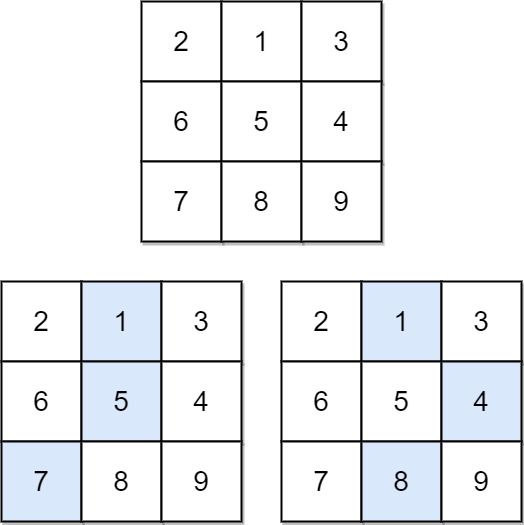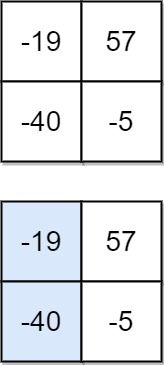| comments | difficulty | edit_url | tags | |||
|---|---|---|---|---|---|---|
true |
Medium |
|
Given an n x n array of integers matrix, return the minimum sum of any falling path through matrix.
A falling path starts at any element in the first row and chooses the element in the next row that is either directly below or diagonally left/right. Specifically, the next element from position (row, col) will be (row + 1, col - 1), (row + 1, col), or (row + 1, col + 1).
Example 1:
Input: matrix = [[2,1,3],[6,5,4],[7,8,9]] Output: 13 Explanation: There are two falling paths with a minimum sum as shown.
Example 2:
Input: matrix = [[-19,57],[-40,-5]] Output: -59 Explanation: The falling path with a minimum sum is shown.
Constraints:
n == matrix.length == matrix[i].length1 <= n <= 100-100 <= matrix[i][j] <= 100
class Solution:
def minFallingPathSum(self, matrix: List[List[int]]) -> int:
n = len(matrix)
f = [0] * n
for row in matrix:
g = [0] * n
for j, x in enumerate(row):
l, r = max(0, j - 1), min(n, j + 2)
g[j] = min(f[l:r]) + x
f = g
return min(f)class Solution {
public int minFallingPathSum(int[][] matrix) {
int n = matrix.length;
var f = new int[n];
for (var row : matrix) {
var g = f.clone();
for (int j = 0; j < n; ++j) {
if (j > 0) {
g[j] = Math.min(g[j], f[j - 1]);
}
if (j + 1 < n) {
g[j] = Math.min(g[j], f[j + 1]);
}
g[j] += row[j];
}
f = g;
}
// return Arrays.stream(f).min().getAsInt();
int ans = 1 << 30;
for (int x : f) {
ans = Math.min(ans, x);
}
return ans;
}
}class Solution {
public:
int minFallingPathSum(vector<vector<int>>& matrix) {
int n = matrix.size();
vector<int> f(n);
for (auto& row : matrix) {
auto g = f;
for (int j = 0; j < n; ++j) {
if (j) {
g[j] = min(g[j], f[j - 1]);
}
if (j + 1 < n) {
g[j] = min(g[j], f[j + 1]);
}
g[j] += row[j];
}
f = move(g);
}
return *min_element(f.begin(), f.end());
}
};func minFallingPathSum(matrix [][]int) int {
n := len(matrix)
f := make([]int, n)
for _, row := range matrix {
g := make([]int, n)
copy(g, f)
for j, x := range row {
if j > 0 {
g[j] = min(g[j], f[j-1])
}
if j+1 < n {
g[j] = min(g[j], f[j+1])
}
g[j] += x
}
f = g
}
return slices.Min(f)
}function minFallingPathSum(matrix: number[][]): number {
const n = matrix.length;
const f: number[] = new Array(n).fill(0);
for (const row of matrix) {
const g = f.slice();
for (let j = 0; j < n; ++j) {
if (j > 0) {
g[j] = Math.min(g[j], f[j - 1]);
}
if (j + 1 < n) {
g[j] = Math.min(g[j], f[j + 1]);
}
g[j] += row[j];
}
f.splice(0, n, ...g);
}
return Math.min(...f);
}
